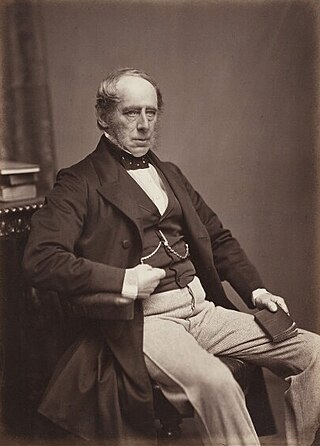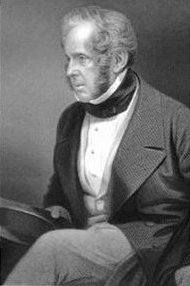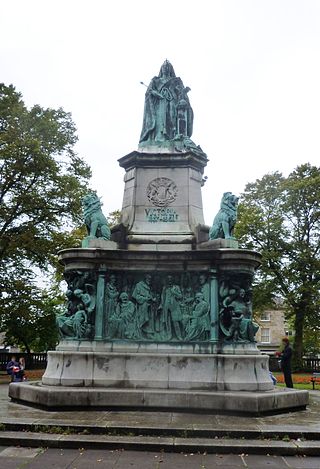
Earl of Derby is a title in the Peerage of England. The title was first adopted by Robert de Ferrers, 1st Earl of Derby, under a creation of 1139. It continued with the Ferrers family until the 6th Earl forfeited his property toward the end of the reign of Henry III and died in 1279. Most of the Ferrers property and the Derby title were then held by the family of Henry III. The title merged in the Crown upon Henry IV's accession to the throne in 1399.

John Somerset Pakington, 1st Baron Hampton,, known as Sir John Pakington, Bt, from 1846 to 1874, was a British Conservative politician.

Thomas Parker, 1st Earl of Macclesfield, was an English Whig politician who sat in the House of Commons from 1705 to 1710. He was Lord Chief Justice from 1710 to 1718 and acted briefly as one of the regents before the arrival of King George I in Britain. His career ended when he was convicted of corruption on a massive scale and he spent the later years of his life in retirement at his home, Shirburn Castle in Oxfordshire.

The Liberal government of the United Kingdom of Great Britain and Ireland that began in 1859 and ended in 1866 consisted of two ministries: the second Palmerston ministry and the second Russell ministry.

John Raphael Smith was a British painter and mezzotinter. He was the son of Thomas Smith of Derby, the landscape painter, and father of John Rubens Smith, a painter who emigrated to the United States.

All Saints' Church, Bakewell, is the parish church of Bakewell, Derbyshire, England. It is a Grade I listed building.

This is a list of Sheriffs of Derbyshire from 1567 until 1974 and High Sheriffs since.
This is a list of High Sheriffs of Lincolnshire.
Events from the year 1799 in Great Britain.
The following lists events that happened during 1879 in New Zealand.
The following lists events that happened during 1868 in New Zealand.

The Baronetcy of Gresley of Drakelow was created in the Baronetage of England on 29 June 1611 for George Gresley of Drakelow Hall, Derbyshire who was later High Sheriff of Derbyshire and Member of Parliament for Newcastle-under-Lyme.
The Sheriff of Nottinghamshire, Derbyshire and the Royal Forests is a position established by the Normans in England.

The office of Lord Mayor of Liverpool has existed in one form or another since the foundation of Liverpool as a borough by the Royal Charter of King John in 1207, simply being referred to as the Mayor of Liverpool. The position is now a mostly ceremonial role. The current Lord Mayor of Liverpool is Richard Kemp, who has held the post since May 2024.
Sir Thomas was a British Thoroughbred racehorse. In a career that lasted from October 1787 to May 1790 he ran thirteen or fourteen times and won nine or ten races. In 1788 he became the first horse owned by a member of the British royal family to win The Derby, having been bought as a two-year-old by the Prince of Wales who later became King George IV. Following his win in the Derby, Sir Thomas raced in the Prince's ownership with some success until 1790.
The 1916 Derby by-election was a parliamentary by-election held for the House of Commons constituency of Derby, the county town of Derbyshire on 29 December 1916.

The Queen Victoria Memorial in Lancaster, Lancashire, England, is a Grade II* listed building. It stands in the centre of Dalton Square, Lancaster facing Lancaster Town Hall. It was erected in 1906, being commissioned and paid for by James Williamson, 1st Baron Ashton.
The 1869 Birthday Honours were appointments by Queen Victoria to various orders and honours to reward and highlight good works by citizens of the British Empire. The appointments were made to celebrate the official birthday of the Queen, and were published in The London Gazette on 2 June 4 June and 1 July 1869.
The 1877 Birthday Honours were appointments by Queen Victoria to various orders and honours to reward and highlight good works by citizens of the British Empire. The appointments were made to celebrate the official birthday of the Queen, and were published in The London Gazette on 30 May and 2 June 1877.









